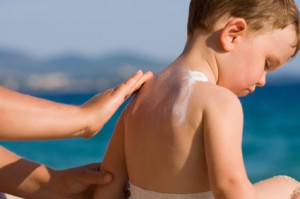
Every spring, we begin seeing the magazine articles and public service announcements reminding us to wear sunscreen to prevent skin cancer.
But if you’re a fair-skinned 20-something like me, you might be tempted to disregard that information. Those same magazines that warn us about skin cancer tend to run the threatening articles next to ads with attractive, tan models. We’re told getting a tan could lead to deadly melanoma, yet pale skin seems to only be considered attractive if you’re a character in the “Twilight” series.
Then I met 81-year-old Dennis Hassel. Hassel, who lives in Stanardsville, Va., estimates he’s had 75-100 basal cell carcinomas, a common form of skin cancer, including about 30 spots on his face. He has a standing appointment with UVA’s dermatology clinic every three months to have cancerous spots removed.
And like me, Hassel used to think he looked good with a tan. “I wish I had known years ago, when I thought I was a sun god out there, what was going to happen.”
Skin Cancer: The Most Common Form of Cancer
More than 3.5 million U.S. residents are diagnosed with skin cancer each year, according to the Skin Cancer Foundation. That includes several thousand diagnosed through UVA’s dermatology clinic.
There are three common types of skin cancer. The vast majority of cases are basal cell carcinoma, a slow growing cancer, says Mark Russell, MD, vice chair of UVA’s Department of Dermatology. Squamous cell carcinoma is the second most common, while melanoma, the most deadly form, is the rarest of the three. Melanoma is more likely to spread and harder to treat, Russell says.
Hassel says his basal cell carcinomas are usually oval-shaped red spots, one-fourth of an inch or a little longer. They sometimes bleed and don’t heal, one of the symptoms of skin cancer.
He often undergoes a treatment called Mohs surgery, where the doctor cuts out his spot, sends it to a lab and gets the results while Hassel waits. If all the cancer is gone, the doctor stitches up the spot where it was. But sometimes the doctor has to go back multiple times to get it all out.
Afterwards, Hassel says, if the spot was on his face or neck, he has to sleep sitting up.
“That doesn’t bother me,” he says. “I think I’m very fortunate to have it done, and they catch it all and it’s fine.”
But not everyone who gets skin cancer will be fine. One person dies of melanoma every hour, the Skin Cancer Foundation says. It’s the most common form of cancer in adults 25-29 years old.
Basking in the UV Rays
Skin cancer happens like this: The sun produces two types of ultraviolet (UV) rays that reach the earth’s surface, UVA and UVB. The rays damage the DNA in skin cells, which can then turn into cancerous cells.
Hassel believes his skin was initially damaged when he was in his 20’s and had X-ray treatment for acne and rashes. But he lived in California and spent several hours outside every day, often just in shorts or a bathing suit, “laying down in the sun and baking,” he says.
He started to get the cancerous spots when he was about 30. Now he wears 100 SPF sunscreen, and he encourages others to remember to put it on their noses and ears.
“I can’t say enough about getting the word out to people who think they’re immune to the sun,” he says. “They’re not.”
Preventing Skin Cancer
Keep an eye on moles and other spots on your skin. The American Academy of Dermatology has a step-by-step guide for performing a self-exam.
See the doctor if you notice:
- Moles or spots that change
- Any of the ABCDE’s of melanoma
- A growth or sore that bleeds sometimes and doesn’t heal
You can see more warning signs and images of specific skin cancers at the Skin Cancer Foundation.
It’s not enough to just put on sunscreen with a high SPF at the beginning of a day outdoors. SPF stands for Sun Protection Factor, and it indicates how much longer you could stay outside in the sun with the sunscreen versus if you have no sunscreen on. For example, if you could be in the sun for 10 minutes before you begin burning, a sunscreen with an SPF of 15 should, in theory, protect you for 150 minutes. But it’s not that simple, Russell warns.
Sunscreen breaks down, wears off, washes off and sweats off. And regardless of what the label may say (the FDA set new regulations about how sunscreens can be labeled, but they aren’t in effect yet), no sunscreen is really waterproof or sweatproof, Russell says.
So he recommends that you:
- Apply sunscreen 15-20 minutes before going outside
- Use a broad-spectrum sunscreen that protects against both UVA and UVB rays
- Don’t skimp on it. You need about an ounce to cover your body — the amount it would take to fill a shot glass
- Reapply every 1-2 hours, regardless of the SPF
- Check the expiration date - sunscreen can expire and become less effective, but the FDA mandates it has to last three years
- Seek shade when possible and avoid sun exposure between 10 a.m.- 4 p.m., the hottest part of the day
Russell also recommends you wear a wide-brimmed hat. His patients who come in with baseball caps still have sunburned necks and ears.
Get Screened and Checked
Have a suspicious spot on your skin? Find a dermatologist.